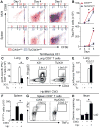Coinfection. Virus-helminth coinfection reveals a microbiota-independent mechanism of immunomodulation
- PMID: 25082704
- PMCID: PMC4548887
- DOI: 10.1126/science.1256942
Coinfection. Virus-helminth coinfection reveals a microbiota-independent mechanism of immunomodulation
Abstract
The mammalian intestine is colonized by beneficial commensal bacteria and is a site of infection by pathogens, including helminth parasites. Helminths induce potent immunomodulatory effects, but whether these effects are mediated by direct regulation of host immunity or indirectly through eliciting changes in the microbiota is unknown. We tested this in the context of virus-helminth coinfection. Helminth coinfection resulted in impaired antiviral immunity and was associated with changes in the microbiota and STAT6-dependent helminth-induced alternative activation of macrophages. Notably, helminth-induced impairment of antiviral immunity was evident in germ-free mice, but neutralization of Ym1, a chitinase-like molecule that is associated with alternatively activated macrophages, could partially restore antiviral immunity. These data indicate that helminth-induced immunomodulation occurs independently of changes in the microbiota but is dependent on Ym1.
Copyright © 2014, American Association for the Advancement of Science.
Conflict of interest statement
The authors declare no other potential conflicts of interest.
Figures




Comment in
-
Immunology. How helminths go viral.Science. 2014 Aug 1;345(6196):517-8. doi: 10.1126/science.1258443. Epub 2014 Jul 31. Science. 2014. PMID: 25082688 No abstract available.
-
What lies within: coinfections and immunity.Cell Host Microbe. 2014 Aug 13;16(2):145-147. doi: 10.1016/j.chom.2014.07.014. Cell Host Microbe. 2014. PMID: 25121741 Free PMC article.
-
A helminth-mediated viral awakening.Trends Immunol. 2014 Oct;35(10):452-3. doi: 10.1016/j.it.2014.08.004. Epub 2014 Aug 28. Trends Immunol. 2014. PMID: 25174993
References
-
- Macpherson AJ, Harris NL. Interactions between commensal intestinal bacteria and the immune system. Nat Rev Immunol. 2004;4:478. - PubMed
Publication types
MeSH terms
Substances
Associated data
Grants and funding
- P30-AI045008/AI/NIAID NIH HHS/United States
- 5T32A100716334/PHS HHS/United States
- AI083022/AI/NIAID NIH HHS/United States
- R01 AI095466/AI/NIAID NIH HHS/United States
- AI061570/AI/NIAID NIH HHS/United States
- HHSN272201300006C/AI/NIAID NIH HHS/United States
- P01 AI106697/AI/NIAID NIH HHS/United States
- AI102942/AI/NIAID NIH HHS/United States
- R01 AI 084887/AI/NIAID NIH HHS/United States
- AI087990/AI/NIAID NIH HHS/United States
- U19 AI082630/AI/NIAID NIH HHS/United States
- R01 AI102942/AI/NIAID NIH HHS/United States
- R21 AI087990/AI/NIAID NIH HHS/United States
- P30-DK050306/DK/NIDDK NIH HHS/United States
- U01 AI095608/AI/NIAID NIH HHS/United States
- R01 AI061570/AI/NIAID NIH HHS/United States
- R01 AI074878/AI/NIAID NIH HHS/United States
- MR/J001929/1/MRC_/Medical Research Council/United Kingdom
- R01 AI084887/AI/NIAID NIH HHS/United States
- U19 AI083022/AI/NIAID NIH HHS/United States
- K08 DK097301/DK/NIDDK NIH HHS/United States
- P30 DK050306/DK/NIDDK NIH HHS/United States
- T32 AI007532/AI/NIAID NIH HHS/United States
- AI082630/AI/NIAID NIH HHS/United States
- K08-DK097301/DK/NIDDK NIH HHS/United States
- F32 AI085828/AI/NIAID NIH HHS/United States
- AI106697/AI/NIAID NIH HHS/United States
- P30 AI045008/AI/NIAID NIH HHS/United States
- AI074878/AI/NIAID NIH HHS/United States
- T32-AI007532/AI/NIAID NIH HHS/United States
- 095831/Wellcome Trust/United Kingdom
- 2-P30 CA016520/CA/NCI NIH HHS/United States
- AI095608/AI/NIAID NIH HHS/United States
- P30 CA016520/CA/NCI NIH HHS/United States
- R01 AI097333/AI/NIAID NIH HHS/United States
- AI095466/AI/NIAID NIH HHS/United States
- F32-AI085828/AI/NIAID NIH HHS/United States
- AI097333/AI/NIAID NIH HHS/United States
LinkOut - more resources
Full Text Sources
Other Literature Sources
Medical
Molecular Biology Databases
Research Materials
Miscellaneous

